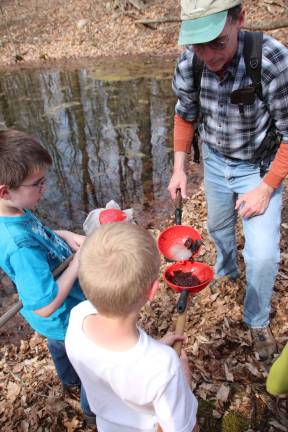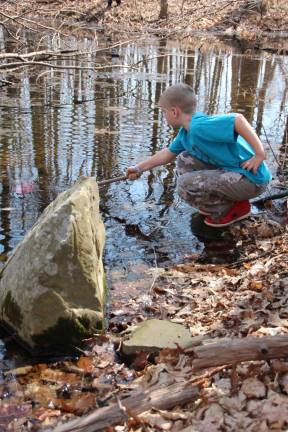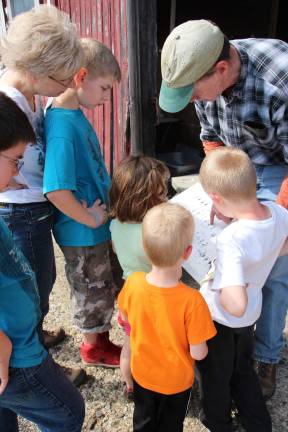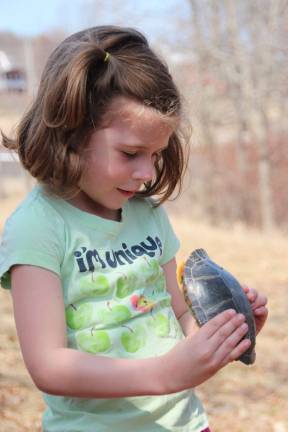Area children get look at vernal ponds




SUSSEX — Hikers enjoyed the 80-degree weather on Saturday, exploring the trails at Lusscroft Farm on an hour-and-a-half, two-mile trek led by Heritage and Agriculture Association, Inc. volunteer Kevin Mitchell.
“In early spring, water collects in depressions in the ground where it forms pools that remain until summer," Mitchell said. "These ‘vernal ponds’ are temporary, but recur in the same location each year. They lack inflow and outflow and don’t contain fish.”
Mitchell said the colder and longer winter has affected the activity of the frogs and salamanders and Mitchell hoped the recent run of warm weather would have made the pond organisms more active.
The hike covered the Sugar Bush (895 ft.), JanineEdMikeAudrey (1650 ft.) and Great (2860 ft.) Trails on the farm. Just emerging from maple sugaring season where H&AA volunteers tap into the trees in late February to collect sap for maple syrup, sold during the open house event every March, the group of 20 hikers was introduced to three of the half-dozen vernal ponds around Lusscroft to search for Wood Frog, Spotted Salamander and Redback Salamander eggs.
Hikers also were told to keep a look out for American Toads, Upland Chorus Frogs and Spring Peepers. Peepers, as Mitchell describes, are “tiny frogs, no bigger than my thumbnail!”
The way you can tell the difference between salamander and frog eggs, according to Mitchell, is not by observing color, but by keeping an eye out for layers.
"Both salamanders and frogs lay eggs in clumps, but salamanders put another coating over all the eggs,” he said.
Mitchell says although both the frogs and salamanders begin breeding around this time, everything is dependent on temperature, weather and so on. However, it’s usually the salamanders that start their reproductive cycles first.
“The male Spotted Salamander, for example, will leave his sperm on the bottom of the pond. The sperm attracts the females, who then fertilize themselves with it.”
More than meets the eye
Cooper Mateja, 9 of Ogdensburg collected pond samples with Mitchell and stored them in jars to be observed under microscopes.
“It’s a lesson in the food web, where everything is interconnected," Mitchell said. "The frogs and salamanders, for example, will eat plant material and pond micro-organisms. I wanted to show the kids who signed up for this hike and demonstrated a genuine interest in vernal pond life that when you look at the water, there’s always something else going on beyond the surface.”
Cooper’s mom, Amy Mateja, said she brought her son on the hike to give him a proper appreciation for nature.
“Kids don’t play outside anymore,” she said.
Their second hike at Lusscroft, the Matejas participated in the farm’s Autumn Leaves Annual Hike on Oct. 6, Cooper's birthday.
The salamander and frog eggs should hatch in about one to three weeks.
“Some of the people on the hike were noticing brightly-colored red salamanders walking around on land," Mitchell said. "Those ones are called Red Eft Salamanders, or Eastern Red-spotted Newts. Their bright coloration serves as a warning to predators.”
The Red Eft is the immature stage of that particular salamander after having hatched and emerged from the water. The adult newts and larvae use gills to breathe and live in water, while terrestrial juveniles (Red Efts) develop lungs and mature as land dwellers. Afterwards, they darken in color and return to the pond.
This was the first hike Lafayette residents Daniel Hayenhjelm and wife, Nancy, participated in with their son, Harrison Hayenhjelm, 11.
They all agreed, “It was a great time.”
— Photos by Gale Miko
For more photos, visit www.advertisernewsnorth.com